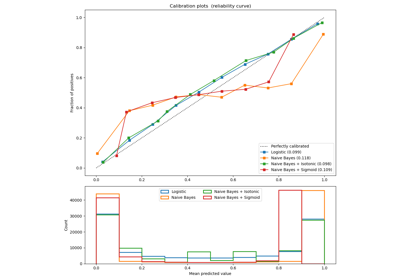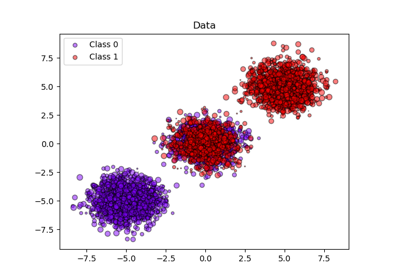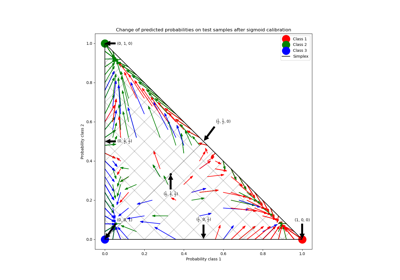sklearn.calibration.CalibratedClassifierCV¶
-
class
sklearn.calibration.CalibratedClassifierCV(base_estimator=None, *, method='sigmoid', cv=None, n_jobs=None, ensemble=True)[source]¶ Probability calibration with isotonic regression or logistic regression.
This class uses cross-validation to both estimate the parameters of a classifier and subsequently calibrate a classifier. With default
ensemble=True, for each cv split it fits a copy of the base estimator to the training subset, and calibrates it using the testing subset. For prediction, predicted probabilities are averaged across these individual calibrated classifiers. Whenensemble=False, cross-validation is used to obtain unbiased predictions, viacross_val_predict, which are then used for calibration. For prediction, the base estimator, trained using all the data, is used. This is the method implemented whenprobabilities=Trueforsklearn.svmestimators.Already fitted classifiers can be calibrated via the parameter
cv="prefit". In this case, no cross-validation is used and all provided data is used for calibration. The user has to take care manually that data for model fitting and calibration are disjoint.The calibration is based on the decision_function method of the
base_estimatorif it exists, else on predict_proba.Read more in the User Guide.
- Parameters
- base_estimatorestimator instance, default=None
The classifier whose output need to be calibrated to provide more accurate
predict_probaoutputs. The default classifier is aLinearSVC.- method{‘sigmoid’, ‘isotonic’}, default=’sigmoid’
The method to use for calibration. Can be ‘sigmoid’ which corresponds to Platt’s method (i.e. a logistic regression model) or ‘isotonic’ which is a non-parametric approach. It is not advised to use isotonic calibration with too few calibration samples
(<<1000)since it tends to overfit.- cvint, cross-validation generator, iterable or “prefit”, default=None
Determines the cross-validation splitting strategy. Possible inputs for cv are:
None, to use the default 5-fold cross-validation,
integer, to specify the number of folds.
An iterable yielding (train, test) splits as arrays of indices.
For integer/None inputs, if
yis binary or multiclass,StratifiedKFoldis used. Ifyis neither binary nor multiclass,KFoldis used.Refer to the User Guide for the various cross-validation strategies that can be used here.
If “prefit” is passed, it is assumed that
base_estimatorhas been fitted already and all data is used for calibration.Changed in version 0.22:
cvdefault value if None changed from 3-fold to 5-fold.- n_jobsint, default=None
Number of jobs to run in parallel.
Nonemeans 1 unless in ajoblib.parallel_backendcontext.-1means using all processors.Base estimator clones are fitted in parallel across cross-validation iterations. Therefore parallelism happens only when
cv != "prefit".See Glossary for more details.
New in version 0.24.
- ensemblebool, default=True
Determines how the calibrator is fitted when
cvis not'prefit'. Ignored ifcv='prefit'.If
True, thebase_estimatoris fitted using training data and calibrated using testing data, for eachcvfold. The final estimator is an ensemble ofn_cvfitted classifer and calibrator pairs, wheren_cvis the number of cross-validation folds. The output is the average predicted probabilities of all pairs.If
False,cvis used to compute unbiased predictions, viacross_val_predict, which are then used for calibration. At prediction time, the classifier used is thebase_estimatortrained on all the data. Note that this method is also internally implemented insklearn.svmestimators with theprobabilities=Trueparameter.New in version 0.24.
- Attributes
- classes_ndarray of shape (n_classes,)
The class labels.
- calibrated_classifiers_list (len() equal to cv or 1 if
cv="prefit"orensemble=False) The list of classifier and calibrator pairs.
When
cv="prefit", the fittedbase_estimatorand fitted calibrator.When
cvis not “prefit” andensemble=True,n_cvfittedbase_estimatorand calibrator pairs.n_cvis the number of cross-validation folds.When
cvis not “prefit” andensemble=False, thebase_estimator, fitted on all the data, and fitted calibrator.
Changed in version 0.24: Single calibrated classifier case when
ensemble=False.
References
- 1
Obtaining calibrated probability estimates from decision trees and naive Bayesian classifiers, B. Zadrozny & C. Elkan, ICML 2001
- 2
Transforming Classifier Scores into Accurate Multiclass Probability Estimates, B. Zadrozny & C. Elkan, (KDD 2002)
- 3
Probabilistic Outputs for Support Vector Machines and Comparisons to Regularized Likelihood Methods, J. Platt, (1999)
- 4
Predicting Good Probabilities with Supervised Learning, A. Niculescu-Mizil & R. Caruana, ICML 2005
Examples
>>> from sklearn.datasets import make_classification >>> from sklearn.naive_bayes import GaussianNB >>> from sklearn.calibration import CalibratedClassifierCV >>> X, y = make_classification(n_samples=100, n_features=2, ... n_redundant=0, random_state=42) >>> base_clf = GaussianNB() >>> calibrated_clf = CalibratedClassifierCV(base_estimator=base_clf, cv=3) >>> calibrated_clf.fit(X, y) CalibratedClassifierCV(base_estimator=GaussianNB(), cv=3) >>> len(calibrated_clf.calibrated_classifiers_) 3 >>> calibrated_clf.predict_proba(X)[:5, :] array([[0.110..., 0.889...], [0.072..., 0.927...], [0.928..., 0.071...], [0.928..., 0.071...], [0.071..., 0.928...]])
>>> from sklearn.model_selection import train_test_split >>> X, y = make_classification(n_samples=100, n_features=2, ... n_redundant=0, random_state=42) >>> X_train, X_calib, y_train, y_calib = train_test_split( ... X, y, random_state=42 ... ) >>> base_clf = GaussianNB() >>> base_clf.fit(X_train, y_train) GaussianNB() >>> calibrated_clf = CalibratedClassifierCV( ... base_estimator=base_clf, ... cv="prefit" ... ) >>> calibrated_clf.fit(X_calib, y_calib) CalibratedClassifierCV(base_estimator=GaussianNB(), cv='prefit') >>> len(calibrated_clf.calibrated_classifiers_) 1 >>> calibrated_clf.predict_proba([[-0.5, 0.5]]) array([[0.936..., 0.063...]])
Methods
fit(X, y[, sample_weight])Fit the calibrated model.
get_params([deep])Get parameters for this estimator.
predict(X)Predict the target of new samples.
Calibrated probabilities of classification.
score(X, y[, sample_weight])Return the mean accuracy on the given test data and labels.
set_params(**params)Set the parameters of this estimator.
-
fit(X, y, sample_weight=None)[source]¶ Fit the calibrated model.
- Parameters
- Xarray-like of shape (n_samples, n_features)
Training data.
- yarray-like of shape (n_samples,)
Target values.
- sample_weightarray-like of shape (n_samples,), default=None
Sample weights. If None, then samples are equally weighted.
- Returns
- selfobject
Returns an instance of self.
-
get_params(deep=True)[source]¶ Get parameters for this estimator.
- Parameters
- deepbool, default=True
If True, will return the parameters for this estimator and contained subobjects that are estimators.
- Returns
- paramsdict
Parameter names mapped to their values.
-
predict(X)[source]¶ Predict the target of new samples. The predicted class is the class that has the highest probability, and can thus be different from the prediction of the uncalibrated classifier.
- Parameters
- Xarray-like of shape (n_samples, n_features)
The samples.
- Returns
- Cndarray of shape (n_samples,)
The predicted class.
-
predict_proba(X)[source]¶ Calibrated probabilities of classification.
This function returns calibrated probabilities of classification according to each class on an array of test vectors X.
- Parameters
- Xarray-like of shape (n_samples, n_features)
The samples.
- Returns
- Cndarray of shape (n_samples, n_classes)
The predicted probas.
-
score(X, y, sample_weight=None)[source]¶ Return the mean accuracy on the given test data and labels.
In multi-label classification, this is the subset accuracy which is a harsh metric since you require for each sample that each label set be correctly predicted.
- Parameters
- Xarray-like of shape (n_samples, n_features)
Test samples.
- yarray-like of shape (n_samples,) or (n_samples, n_outputs)
True labels for
X.- sample_weightarray-like of shape (n_samples,), default=None
Sample weights.
- Returns
- scorefloat
Mean accuracy of
self.predict(X)wrt.y.
-
set_params(**params)[source]¶ Set the parameters of this estimator.
The method works on simple estimators as well as on nested objects (such as
Pipeline). The latter have parameters of the form<component>__<parameter>so that it’s possible to update each component of a nested object.- Parameters
- **paramsdict
Estimator parameters.
- Returns
- selfestimator instance
Estimator instance.



